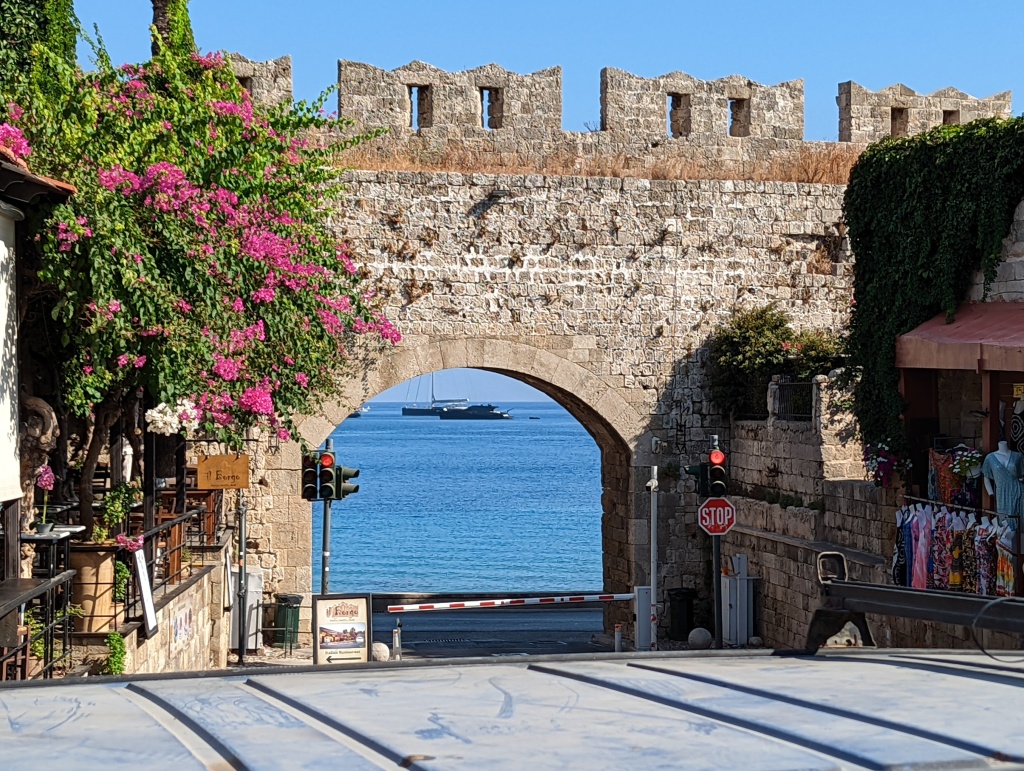
The lush island of Rhodes is the largest of Greece’s Dodecanese islands and our last stop in Greece. It is situated at the crossroads of the two sea routes of the Mediterranean, between the Aegean Sea and the coasts of the Middle East. Best known for its well-fortified and exquisitely preserved Old Town, Rhodes is surrounded by areas that paint a very different picture.
The Medieval Old Town contains remnants of the many civilizations that have left their marks. Its unique architectural style combines Byzantine, French, and Spanish influences. The imposing Palace of the Grand Masters, Byzantine temples, buildings left by the Knights of St. John including a hospital, stone-paved streets, mosques, a Jewish synagogue, Orthodox churches, and lively squares come together to form a complex mosaic.





The Knights of St. John were a religious order founded in the 11th century. Members represented eight major European Catholic countries and divided themselves strictly into exclusive classes based on their degree of aristocracy. Their primary objective initially was to care for wounded and ailing crusaders, serving as soldiers, nurses, and clerics based on their skills. Occupying Rhodes in 1310, they brought great wealth to the island and left their mark by building massive buildings such as the Palace of the Grand Master and the Knights Hospital. Strolling up and down the Street of the Knights, visitors are provided with glimpses of what life was like during their occupation. The quarters of the various nationalities represented in the knights are located along the pebbled street. The knights fled to Malta in 1522 when the Turks were finally triumphant, but much of their influence remains.




The Palace of the Grand Masters is the most significant building in Old Town. Originally built on the foundation of the Temple of the Sun God Helios, it was the seat of government and home to the Grand Master during Medieval times. It was largely destroyed in 1856 by explosives hidden in the basement of the nearby Church of St. John. At the beginning of the 20th century, it was magnificently restored as a holiday retreat for Mussolini. Although he never actually got the chance to visit, he decorated the palace using floors of intricate mosaics found during archaeological restorations on the nearby island of Cos and furnishings of ornate Italian design.







In addition to numerous historical venues, Old Town is home to some 6,000 people who live here. Their homes and cafes are tucked into quaint side streets, where we stopped for lunch before heading outside to explore more of the island.




Making our way on foot through modern residential neighborhoods to the less populated countryside, we were surprised to find groves of citrus and olive trees soaking up the Aegean sun and forests of cypress and pine trees covering the hillsides. As we hiked Rhodes’ expansive Acropolis area (not the better-known Acropolis of Lindor nearby), we found breathtaking rocky slopes overlooking beautiful beaches. Yet to be fully excavated, this acropolis is a surprising and delightful place that we had almost to ourselves!






Our visit to Rhodes was exhilarating and rewarding. Logging in almost seven miles, we had the opportunity to travel through centuries of triumph and struggle. Back to the port, we agreed that this final day in Greece was one we’ll remember fondly for a long time.


WOW !! Happy you were able to explore this magnificent area “on your own.” Looking good, especially your fleet feet…lol !! Truly memorable final day in Greece. Thanks for sharing ♥️❤️
LikeLiked by 1 person
Doug & Denise,
Enjoying your Blog of one of the greatest civilizations, safe travels!
Dan Mormile
LikeLiked by 1 person
Fantastic photos, and a wonderful day of exploration for the two of you! What great
memories you have to bring home. Also, good photos of both of you!💕
LikeLike
how lovely and as usual, your descriptions are so vivid, that I feel as though I’m there. Taylor still says that her fave places to visit while living in Europe were Greece and Ireland. Just breathtaking Denise and Doug. Continue to enjoy.
LikeLiked by 1 person
I won’t disagree with Taylor💖
LikeLike